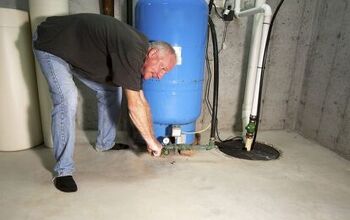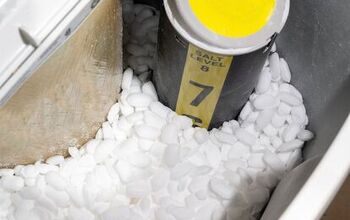How Does Water Get Into A Sump Pit?

If you have a basement or crawl space under your home, you may have a sump pit. This hole in the basement floor collects groundwater and prevents flooding in your basement or crawlspace. Many homeowners wonder how the water gets to the sump pit.
Water typically flows into the sump pit under your home through special drains under the basement floor. These drains sometimes referred to as French drains, collect the water on the perimeter wall of the basement and direct it into the sump pit. Some older homes rely on the natural migration of water through the soil instead of drains.
Sump pits are common in areas with high water tables or that experience large rainfall. If you have a sump pit and sump pump in your home, it requires maintenance and attention to operate properly. The drains that feed water into the sump pit also need periodic attention to ensure they aren’t clogged or damaged.
No one wants a damp and musty basement. Moisture in a basement or crawlspace in your home can also be unhealthy. Moisture promotes mold and mildew growth which can adversely affect your health.
Do You Need Sump Pump Repair or Replacement?
Get free, zero-commitment quotes from pro contractors near you.

How Do Sump Systems Work?
The short answer is, a sump system moves water from where you don’t want it to a place you can deal with it. What that doesn’t tell you is how a sump system manages this task. To fully understand how a sump system works, you must understand how water behaves.
Water is at the center of why sump pumps are installed in basements and crawlspaces. As water percolates through the soil, it tends to follow the path of least resistance. If you build a house where water wants to flow, the result can be flooded basements or crawlspaces. Water moving through the soil that encounters a basement wall or foundation often collects or pools in the soil, creating major problems.
Sump systems use water’s natural proclivity to find the path of least resistance to move the water to handle and remove it. This usually involves several components. The major portions of the sump system are French drains, a sump pit, and a sump pump.
Are French Drains Really French?
Contrary to popular belief, French drains were not first conceived by the French. French drains were conceived and popularized by an American named Henry Flag. At this time, home construction was evolving. Basements and crawlspaces were becoming more and more popular. One huge problem was the infiltration of water into these spaces, especially in the northeastern parts of the United States.
A basic French drain consists of a perforated pipe buried in a trench around the perimeter of the basement or foundation. The trench is backfilled with loosely packed gravel that allows water to enter the perforated pipe and drain away. Modern French drains are much more complex than this simple explanation.
The French Drain carries the accumulated water to the sump pit, which is usually located somewhere in the basement or crawlspace of the home. French drains are on the outside of the foundation or under the floor around the interior of a basement. The effect is the same. The water enters the French drain pipe and follows this least path of least resistance to the sump pit.
Sump Pits and Sump Pumps – The Heart of The Sump System
Once the water collected by the french drains is collected in the sump pit, it must be removed before the pit overflows. In a sump system, a sump pump is the key. An automatic sump pump can wait for months if necessary for water to accumulate in the pit.
Once water is in the pit, an automatic switch turns the pump on. The pump outlet is usually connected to the home’s sewer system. The water collected in the sump is transferred to the sewer line and safely moved away from the home.
Is It Possible to Install a Sump and French Drains in an Existing Basement?
The old saying goes that anything is possible, and the impossible costs more. Retrofitting an existing basement is a perfect example of the truth in this case. Several scenarios and factors affect the overall cost of installing french drains and a sump pit in an existing basement. Before you begin a project to add French drains and a sump pit in your basement, you should consider these factors carefully.
Interior Sump System Retrofit
If you have a damp and musty basement, adding a Frenc drain and sump pit may be the only solution. Basement walls can be coated with sealants, but these are usually ineffective or short-lived. In some cases, the only long-term solution is to install a French drain on the perimeter interior wall of the basement.
The Downside of a French Drain RetrofitThe obvious downside of performing a French drain retrofit in a basement is the need to remove portions of the floor to bury the French drain and install the sump pit. This may not be as problematic if your basement is unfinished and used only as a utility space. However, if your basement is a finished living space, the construction can be much more expensive.
In the case of an unfinished basement, opening the floor along the perimeter wall may not pose much of a problem. The concrete can be scored and broken with no wall finishes or floor coverings. However, there is still the noise, dust, and inconvenience you must endure during the project. This p[roject can also be expensive.
If your basement is finished, the cost, time, and effort are multiplied. The finishes, floor coverings, and, in some cases, wall finishes must be removed to allow access to the subfloor. When the sump system installation is complete, the basement finishes must be replaced or restored. However, the effort and expense may be acceptable when faced with a waterlogged basement.
Can’t I Put the French Drain on the Outside of my Basement Wall?
You can put a French drain on the exterior wall of your basement. The reality is that this plan can be more expensive than an interior installation. It must be understood that installing an effective French drain around a home’s exterior is no small project. Serious considerations of what this kind of project entails are a priority.
The French Drain Must be Below the Basement Floor
To effectively keep water out of a basement, the French drain must be installed below the floor level of the basement. To install a French drain on the exterior of a basement wall requires excavating along the outside wall below this level. This often requires large enough excavations to allow workers to safely work at this depth.
Not only does this present an expensive undertaking, but it also can destroy any landscaping around your home. This is an extremely audacious undertaking and typically costs more than an interior installation, even if the basement is finished.
A Sump Pit is Still Required
A sump put in the basement must be installed to remove the water collected by the French drain. Some demolition work must be done in the basement to accommodate the sump pit and pump.
This also requires installing the necessary electrical service for the sump pump. Connections to the sewer system must also be made to carry the water from the sump pit away.
What Problems Are Associated with French Drains?
While French drains and sump pits afford homes with basements a high level of protection, these systems have downsides that must be recognized. Many homeowners put their French drains and sump system out of mind until a problem occurs. Unfortunately, the sump system’s problems are often first recognized when water is in the basement.
French Drains that Don’t Drain
French drains and sump pits are not without their problems. French drains reside underground and collect water that is moving through the soil. This can lead the French Drain pipes to problems with silt and other debris collecting in the French drain pipes.
A French drain that doesn’t drain can’t transport water to the sump pit and the sump pump. Instead, the water backs up and begins to pool in the soil around and under the basement. Eventually, the water will find its way inside.
Unfortunately, unlike regular sewer or waste pipes, most French drains are not easily cleaned. It is not the usual practice to install cleanouts in French drain systems. The only effective way to clean or repair a French drain is to dig it up and install new piping.
What Does it Cost to Install a Sump System?
The cost of installing a French drain and sump system is complicated. Many factors have to be considered. The biggest factor is the timing of the installation. Other factors include the basement situation, the size of the installation, and local codes that may affect the installation.
The Most Cost-Effective Installation
Nationally, installing French drains, a sump pit and a sump pump during construction of your new home adds approximately $2,800 to $8,000. This is the most cost-effective way to protect your basement from water intrusion and is now becoming almost a standard practice.
Installing the French drain and Sump pit during construction avoids the expense of removing the floor later or demolishing existing interior finishes. Performing construction in an ordered sequence saves time, money, and effort in the long run.
Retrofitting an Unfinished Basement
If your basement is unfinished, the cost of installing French drains and a sump pit is expected to cost between $60 and $120 per foot. If your basement is 20 feet by 20 feet, you will need 80 linear feet of French drain. At the top end, this can cost $9.600.
This does not include the cost of installing the sump pit, purchasing and installing a sump pump, and the necessary electrical and plumbing work to connect everything. Installing French drains in an unfinished basement can easily exceed $12,000 to $15,000.
Add the Cost of a Finished Basement
Adding a French drain sump system to a finished basement is much like an unfinished basement. However, you must include the cost of demolition to remove flooring, finishes and wall coverings. Once the installation is complete, these things must be replaced and reinstalled. This can double the cost of a French drain installation in a finished basement.
Do You Need Sump Pump Repair or Replacement?
Get free, zero-commitment quotes from pro contractors near you.

Getting Water Away From Your Basement and Into the Sump Pit
The secret is to get water away from your basement and into the sump pit, where the pump can put it into the sewer system. If you use the natural tendency of water to find the path of least resistance, it can be easy to channel the water to the sump pit. French drain systems can provide this path of least resistance and keep your basement dry.

Dennis is a retired firefighter with an extensive background in construction, home improvement, and remodeling. He worked in the trades part-time while serving as an active firefighter. On his retirement, he started a remodeling and home repair business, which he ran for several years.
More by Dennis Howard



























